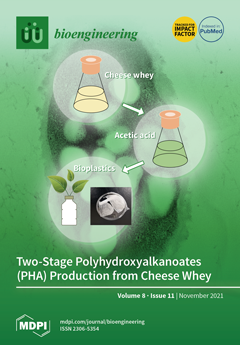Wax is an organic compound found on the surface of lignocellulose biomass to protect plants from physical and biological stresses in nature. With its small mass fraction in biomass, wax has been neglected from inclusion in the design of the biorefinery process. This
[...] Read more.
Wax is an organic compound found on the surface of lignocellulose biomass to protect plants from physical and biological stresses in nature. With its small mass fraction in biomass, wax has been neglected from inclusion in the design of the biorefinery process. This study investigated the interfering effect of wax in three types of lignocellulosic biomass, including rice straw (RS), Napier grass (NG), and sugarcane bagasse (SB). In this study, although small fractions of wax were extracted from RS, NG, and SB at 0.57%, 0.61%, and 1.69%, respectively, dewaxing causes changes in the plant compositions and their functional groups and promotes dissociations of lignocellulose fibrils. Additionally, dewaxing of biomass samples increased reducing sugar by 1.17-, 1.04-, and 1.35-fold in RS, NG, and SB, respectively. The ethanol yield increased by 1.11-, 1.05-, and 1.23-fold after wax removal from RS, NG, and SB, respectively. The chemical composition profiles of the waxes obtained from RS, NG, and SB showed FAME, alcohol, and alkane as the major groups. According to the conversion rate of the dewaxing process and ethanol fermentation, the wax outputs of RS, NG, and SB are 5.64, 17.00, and 6.00 kg/ton, respectively. The current gasoline price is around USD 0.903 per liter, making ethanol more expensive than gasoline. Therefore, in order to reduce the cost of ethanol in the biorefinery industry, other valuable products (such as wax) should be considered for commercialization. The cost of natural wax ranges from USD 2 to 22 per kilogram, depending on the source of the extracted wax. The wax yields obtained from RS, SB, and NG have the potential to increase profits in the biorefining process and could provide an opportunity for application in a wider range of downstream industries than just biofuels.
Full article






